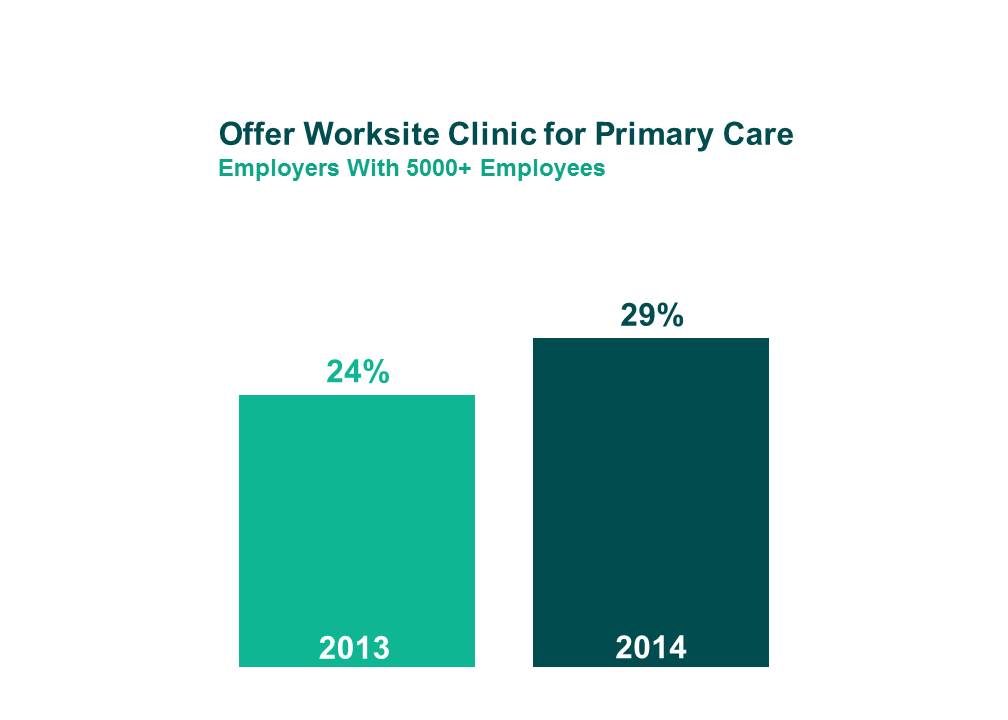Giving Worksite Clinics a New Look

Faced with the prospect of an already-fragmented health care system strained further as more Americans gain health insurance in the public exchanges and through employer plans, employers are turning to onsite clinics as a critical component of their health care strategy. Worksite health services are a way for employers to directly influence health care delivery and provide a convenient and quality product to their employees — enhancing the benefit package while improving productivity.
While the first worksite clinics primarily served to provide first aid and urgent care, today the majority offer general primary care services — and the number is growing. Among employers with 5,000 or more employees — the size group most likely to have implemented a clinic — 29% offer an onsite or near-site primary care clinic, up from 24% last year. An additional 9% offer a clinic for occupational services only. While onsite clinics may be more practical for large worksites, near-site/shared clinics situated in office parks or urban office buildings offer access to smaller employers or large employers with smaller locations.
A Mercer survey of 131 employers that offer an onsite or near-site clinic found that while screenings and immunizations are the most common general medical services offered at worksite clinics, more clinics are introducing expanded comprehensive primary care in which patients with chronic illnesses can be managed on an ongoing basis. Pharmacy services and laboratory tests are the newest offerings, each offered at about a third of the clinics Mercer surveyed.
But the concept of how worksite clinics can be used has shifted and broadened. For example, many employers have positioned their clinics as onsite centers for wellness and health promotion and use them as a way to create a “culture of health” in the workplace and to encourage employee participation in the wellness programs. Of the employers surveyed, the majority use their worksite clinics as a convenient way for employees to undergo biometric screenings (72%), participate in face-to-face chronic condition coaching (63%), and take part in lifestyle management programs such as smoking cessation, weight management (both offered by 60% of clinics), and nutrition management (57%). More recently, worksite clinics have begun to play a role in telehealth — either by offering services directly using clinic providers, or by coordinating with a separate telehealth vendor so that the clinic providers are notified of off-hours activity and get a copy of the record.
Data on return on investment make a good case for companies to add or reshape worksite clinics. Most employers that are able to measure say that the cost of running the clinic accounts for less than 2% or between 2% and 5% of their organization’s total annual health care spending (37% and 36%, respectively). And among employers that have been able to measure ROI, more than half reported a return of 1.5 or greater — and a quarter reported a return of at least 2.5. Only 12% say they have not yet broken even on their investment.
At a time when employers are looking for any possible source of health cost savings, they may find a worksite clinic can deliver that, and more. But increasingly employers are coming to view worksite clinics as a way to ensure that employees — and in some cases employees’ dependents — have easy access to quality care. Significant improvement in productivity is gained by reducing employee time away from work. Most employers in the survey reported average wait times in their clinics of 10 minutes or less. In addition, the convenience of onsite clinics allows and encourages employees to get the preventive care they need every year instead of putting it off.
Tara Lewis assisted with the reporting for this article.
